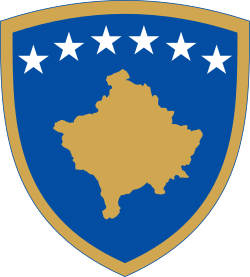Gjilan
Gjilan (Albanian: Gjilani, IPA: [ɟi'lani] (![]()
Gjilan Gilan | |
|---|---|
City and municipality | |
| Komuna e Gjilanit | |
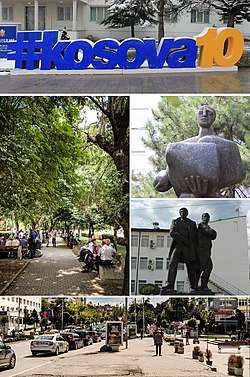 Clockwise from top: 10th Celebration of Independence of Kosovo, The Park, The Unknown Soldier, Rexhep Mala and Nuhi Berisha monument, City Boulevard | |
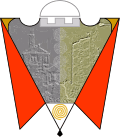 Seal | |
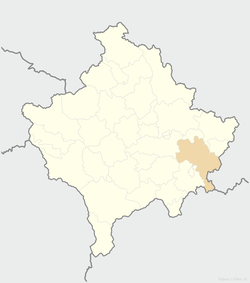 Location of the city of Gjilan within Kosovo | |
| Coordinates: 42°28′N 21°28′E | |
| Country | |
| District | District of Gjilan |
| Government | |
| • Mayor | Lutfi Haziri (LDK) |
| • Municipal | 392 km2 (151 sq mi) |
| Elevation | 508 m (1,667 ft) |
| Population (2011) | |
| • Urban | 54,239 |
| • Municipal | 90,178 |
| • Municipal density | 230/km2 (600/sq mi) |
| Time zone | UTC+1 (CET) |
| • Summer (DST) | UTC+2 (CEST) |
| Postal code | 60000 |
| Area code(s) | +383 280 |
| Car plates | 06 |
| Website | kk |
Geography
Gjilan is located in the southeastern part of Kosovo, the region of Anamorava. It is one of the largest municipalities in the country. Its geographic position makes it possible to make good connections with other centers of Kosovo and the region. Around the town of Gjilan lis the Hill of Martyrs (Popovica), Gllama, Dheu i Bardhë, the area of Malisheva (Gjilan), Zabeli of Sahit Agës and Bregu i Thatë. There are three small rivers, Mirusha, Banja and Stanishori, which join and flow to Binačka Morava, west of the Uglara village.
Gjilan is 46km from Pristina, 27 km from Kamenica, 22 km from Vitina, and 25 km from Novo Brdo. The municipalities of the region are bordered in the southeast by Preševo (33 km) and Kumanovo (53 km), and in the east by Bujanovac (40 km).[1]
The Gjilan area is defined by the Morava River, which collects all the small rivers, with an average monthly flow rate of 6.7 cubic meters/second. In the southeast it is surrounded by the mountains of Karadak.[2]
The coordinates of the city of Gjilan are 42 degrees north and 21.20 degrees east and 501 and 590 m above sea level, while 475 m in Budrike, up to 1000 m altitude in the border zone with North Macedonia.
In seismic maps, Gjilan is known as a region of marked vulnerability to danger. In 2002, it was hit by an earthquake that killed one, injured tens and over 8,000 damaged public and private facilities.
Name
Ottoman chronicler Evliya Çelebi mentions Morava (Serbian Cyrillic: Морава) as a settlement of the Sanjak of Vučitrn. Çelebi writes that: "The seventeen day journey from Constantinople (Istanbul) to pass through Vranje, Novo Brdo, Kriva Reka (Egridere) and Morava (Gjilan). The etymology of Gjilan is disputed. Albanian sources claim that the town (initially a village) obtained its name from Bahti Beg Gjinolli of Gjinaj clan that ruled the region of Vučitrn (Malo Kosovo and Drenica), and populated this area in the 18th century (around 1750).
History
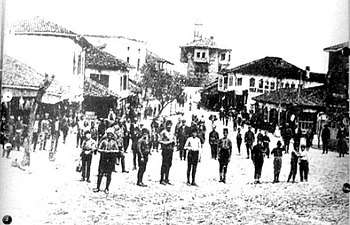
In 1342, a place called Morava was visited by Serbian King Stefan Dušan (later Emperor, r. 1331–1355).[3] A fort was built nearby in the 14th century. Gornja Morava ("Upper Morava") was known as simply Morava under Ottoman rule, and it extended west of the Upper Žegra–Budriga–Cernica line, thus Gjilan stayed in the oblast (province) of Topolnica, which provincial seat was Novo Brdo.[4] In the 1455 defter (Ottoman tax registry), Gjilan was inhabited by Serbs, and the priest Božidar served the town.[5] There were 41 households.[6] Haji Kalfa (first half of the 17th century) mentions Morava being 17 days from Constantinople.[3] Gornja Morava and Izmornik were organized into the Sanjak of Vučitrn up until the 18th century.[7] Gjilan became a kadiluk around 1780, and 20–25 years later a large village.[8]
The exact year of establishment of Gjilan to this day is not exactly determined. In the 17th century, Evlia Çelebija mentions Gjilan, but named Morava, as a cadillac within the Sanjak of Vučitrn. Among other things, Evlia Çelebija writes that "Seventeen days the road from Constantinople (today's Istanbul) to Novo Brdo passes through Vranje, Kriva Reka (Egridere) of Morava (Gjilan)". There is a tradition in the people that Gjilan as a settlement was formed around 1750, and as an urban center – in 1772. Gjilan as a town developed in addition to the extinction of Novo Brdo, which in the Middle Ages was one of the cities and the largest commercial, economic and mining centers in the Balkans. The feudal family "Gjinaj" in the second half of the nineteenth century transferred their headquarters from Novo Brdo and built their own houses in the place where Gjilani is now located.[9]
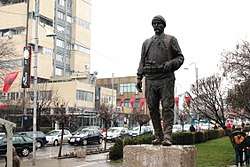
Modern history
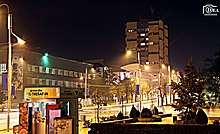
On 23 January 1944 during World War II in Gjilan around 8000 Kosovo Albanians were killed by Yugoslav Partisans. This event is remembered every year in the framework of Flaka e Janarit and named as Gjilan massacre 1944.[10]
In 1999, Camp Monteith was established outside the city as a base of operations for KFOR during Operation Joint Guardian, on the site of a destroyed Serbian military base which was handed over to the Kosovo Protection Corps in 2007 after the U.S. Military downsized their number of troops. Gjilan has also served as the regional headquarters of the UNMIK International Police task force from 1999.
Population
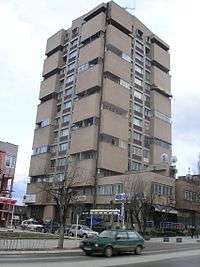
| Year | Pop. | ±% p.a. |
|---|---|---|
| 1953 | 48,748 | — |
| 1961 | 52,415 | +0.91% |
| 1971 | 67,893 | +2.62% |
| 1981 | 84,085 | +2.16% |
| 1991 | 103,675 | +2.12% |
| 2011 | 90,178 | −0.69% |
| 2016 est. | 80,525 | −2.24% |
| Source: Division of Kosovo | ||
The population of Gjilan has always been mixed, but with a predominant majority of Albanians in both periods during Turkish and Serbian-Yugoslav rule. According to the 2011 census, the Municipality of Gjilan has 90,178 inhabitants. Albanians – 87,814, Serbs – 624, Turks – 978, Bosniaks – 121, Roma – 361, Ashkali – 15, Gorani – 69, Egyptians – 1, others – 95. They preferred not to respond – 35 people. In the city live 54,239 inhabitants, while in rural areas – 35,939. Division of population by gender: male – 45,354, female – 44,824.[11] Based on the population estimates from the Kosovo Agency of Statistics in 2016, the municipality has 81,447 inhabitants.
Ethnic groups
The vast majority of the population is Albanian, followed by Serbs, and a small number of minorities. There are among others, 978 Turks or 1% of the municipal population. The number of Serbs has decreased due to partial boycott[12] and the creation of the Serb-majority municipality of Parteš.
The ethnic composition of the municipality:
| Ethnic composition | |||||||||||||
| Year/population | Albanians | % | Serbs | % | Roma | % | Others | % | Total | ||||
|---|---|---|---|---|---|---|---|---|---|---|---|---|---|
| 1953 | 24,797 | 50.87 | 19,196 | 39.32 | 48,748 | ||||||||
| 1961 | 29,942 | 57.12 | 18,297 | 34.91 | 735 | 1.50 | 52,415 | ||||||
| 1971 | 43,754 | 64.45 | 20,237 | 29.81 | 1,824 | 2.69 | 67,893 | ||||||
| 1981 | 59,764 | 71.08 | 19,212 | 22.85 | 3,347 | 3.98 | 1,762 | 2.1 | 84,085 | ||||
| 1991 | 79,357 | 76.54 | 19,370 | 18.68 | 3,477 | 3.4 | 1,471 | 1.4 | 103,675 | ||||
| 1998 | 94,218 | 79.4 | 19,481 | 16.4 | 3,568 | 3 | 1,387 | 1.2 | 118,654 | ||||
| 2011 | 87,814 | 97,45 | 624 | 0,7 | 361 | 0,4 | 1,379 | 1,52 | 90,178 | ||||
| Source: Yugoslav population censuses for data through 1991,and Kosovo 2011 census. | |||||||||||||
Education
Education in Gjilan includes primary and secondary education, and a public university. Currently there are 23,608 Albanian students and 881 minority students enrolled in educational institutions around Gjilan. The primary education ranging from grades 1−5 along with the lower secondary education is obligatory for all citizens and it begins when the child turns 6 years old. It is free of charge.
The second phase of the obligatory education is the so-called lower secondary education which consists of teenagers usually around 12–15 years of age, therefore, grades 6–9. This education, according to the law, is also free of charge and publicly funded. The lower secondary education in Gjilan is held in Albanian, Serbian, and Turkish language.
Higher education is available of attaining in various universities and different educational institutions offering high professional education. Higher education is also available in public or private institutions where the students are offered associate degrees, bachelor's degrees, master's degrees, and PhDs. Various schedules are additionally available where students can choose to pursue their studies full-time or part-time.
Economy
There are 3,700 registered private businesses in the municipality employing 7,900 people. Before 1999, Gjilan was an important industrial centre in Kosovo. Still in operation are the radiator factory and tobacco factory, which has been recently privatized. The new city business incubator, supported by the European Agency for Reconstruction, was inaugurated in the summer of 2007.
Culture
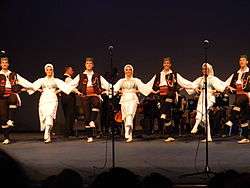
Flaka e Janarit
Flaka e Janarit is a cultural event that starts on January 11 in Gjilan with a symbolic opening of the flame, to keep up with various cultural activities to 31 January of each year. It gathers thousands of artists and art lovers from all the Albanian territories, who for three consecutive weeks transform the city into a cultural metropolis. The nation's martyrs are honored through values of art by this event, which began before the 10th anniversary of the assassination of writer, activist and patriot Jusuf Gërvalla, along with Kadri Zeka and Bardhosh Gërvalla. It was exactly the tenth anniversary without these three martyrs of freedom and from coincidence of these murders in a same date on 11 January, this event got this name "Flaka e Janarit".[14]
There are 41 mosques in Gjilan.[15]
Features
Gjilan is the administrative center of the District of Gjilan of Kosovo. Since February 15, 2003, it is the headquarters of the Local Democracy Agency in Kosovo of the Council of Europe.
Sports
Gjilan is home to the basketball club KB Drita, the football clubs SC Gjilani and FC Drita and the volleyball club KV Drita, male and female competition the most successful club in Gjilan's history. It also has the football club which is in the 2nd league KF Bashkimi from Koretin, a village in Gjilan.
Gjilan hosts the biggest derby in Kosovo, the Kosovo Derby, between FC Drita and SC Gjilani. Both of the clubs are from the city, which draw thousands of viewers inside the Gjilan City Stadium.
Gallery
 City center, 1913
City center, 1913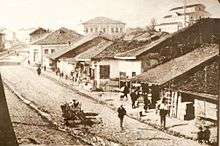 1925
1925 House of Zekirja Abdullahu
House of Zekirja Abdullahu Monastery of St. Nicholas, Straža, Gjilan
Monastery of St. Nicholas, Straža, Gjilan Main Street
Main Street City Theater
City Theater Conservatory
Conservatory Clock Tower
Clock Tower Big Mosque
Big Mosque Oldest Mosque of 1606
Oldest Mosque of 1606 Dunav Church
Dunav Church
Notable people
- Idriz Seferi (b.1847), Albanian patriot
- Mulla Idriz Gjilani (b.1901), Albanian patriot
- Zoran Antić (b. 1975), Serbian footballer
- Faton Bislimi (b. 1983), Kosovan author
- Nijazi Ramadani (b. 1964), Kosovan poetry writer
- Albert Bunjaku (b. 1983), Swiss footballer
- Daut Dauti (b. 1960) Kosovan author
- Dragan Dimić, Serbian footballer
- Bajram Haliti (b. 1955), Romani writer
- Shpëtim Hasani (b. 1982), Kosovan footballer
- Lutfi Haziri (b. 1969), Kosovan politician
- Genta Ismajli (b. 1985), Kosovan singer
- Ismet Munishi (b. 1974), Kosovan footballer
- Aljmir Murati (b. 1985), Swiss footballer
- Zenun Pajaziti (b. 1966), Kosovan politician
- Xherdan Shaqiri (b. 1991), Swiss footballer
- Jahi Jahiu, (b. 1959), Kosovan artist
- Mira Stupica (b. 1923), Serbian actress
- Goran Svilanović (b. 1963), Serbian politician
- Faton Toski (b. 1987), German footballer
- Agim Ramadani (b. 1963), KLA commander
- Abdullah Tahiri (b. 1956), KLA commander
- Antun Marković (b. 1992), Croatian footballer
International relations
Annotations
- Kosovo is the subject of a territorial dispute between the Republic of Kosovo and the Republic of Serbia. The Republic of Kosovo unilaterally declared independence on 17 February 2008, but Serbia continues to claim it as part of its own sovereign territory. The two governments began to normalise relations in 2013, as part of the 2013 Brussels Agreement. Kosovo is currently recognized as an independent state by 97 out of the 193 United Nations member states. In total, 112 UN member states recognized Kosovo at some point, of which 15 later withdrew their recognition.
See also
- Gjimnazi Zenel Hajdini
- Municipalities of Kosovo
- Cities and towns in Kosovo
- Populated places in Kosovo
References
- "Geographical position". Municipality of Gjilan - Official Website. Municipality of Gjilan. Retrieved 31 March 2018.
- "Geographical position". Municipality of Gjilan - Official Website. Municipality of Gjilan. Retrieved 31 March 2018.
- Kostić 1922, p. 126
"ГЊИЛАНЕ. ИЛИ. ГИЉАНЕ. У 14. веку помиње се неко место Морава, где се 1342. год бакио краљ Душан. Хаџи Калфа (прва половина 17. века) помиње неко место Мораву, на 17 дана од Цариграда. Јањева, Новог Брда и Кача- ..." Gnjilane or Giljane. In 14th century some place Morava was mentioned, where king Dusan rested in 1342. Haji Kalfa (first half of the 17th century) mentioned some place Morava, on 17 days (distance) from Istanbul. Janjeva, Novo Brdo and Kaca-..."
- Urošević/Macura 1987, p. 10
"Горња Морава се под турском управом звала само Морава, а протезала се западно од линије с. Жегра–Будрига–Церница, тако да је Гњилане остајало у области Топонице, чије је обласно средиште било Ново Брдо." "Upper Morava under Ottoman rule was called just Morava. It was located Western of the line s. Žegra–Budriga–Cernica, so Gnjilane was in area of Toponica, which regional center was Novo Brdo."
- Kalezić 2002, p. 448
"Из турског дефтера (1455) види се да је насељено Србима и да је у њему служио свештеник Божидар. Старо Гњилане налазило се у Петиковиди (Петковици) предграђу данашњег насеља које је подигнуто на месту" "From the Ottoman Defter (1455) it is seen that it was inhabited by Serbs and that in it the priest Bozidar served. Old Gnjilane was located in Petikovida (Petkovica) suburb of today's settlement which was created in that place"
- Hamid Hadžibegić, Adem Handžić and Ešref Kovačević (1972). Oblast Brankovića – Opširni katastarski popis iz 1455. Sarajevo, Socialist Federal Republic of Yugoslavia: Orijentalni institut Sarajevo.CS1 maint: uses authors parameter (link)
- Urošević/Macura 1987, p. 11
- Cvijić 1930, p. 38
"Гњилане је дакле могло постати тек после овог кадије, око 1780 године, тако да је после 20–25 година, на крају 18 века, могло бити велико село – варошица. При доласку Џинића у новобрдски" "So, Gnjilane was founded only after this kadi, around the year 1780, so it was after 20–25 years, at the end of 18th century, a large village – varošica"
- "The history". https://kk.rks-gov.net/gjilan/. Gjilan municipality. Retrieved 31 March 2018. External link in
|website=(help) - "The names of personalities and events from the territory of the municipality of Gjilan" (PDF). Retrieved 20 January 2019. Cite journal requires
|journal=(help) - "Population Number". Gjilan. Retrieved 11 October 2018.
- "ECMI: Minority figures in Kosovo census to be used with reservations". ECMI.
- OSCE Implementation of the Law on the Use of Languages by Kosovo Municipalities
- Rrustemi, Sabit (2001). Cultural Literary Magazine "Agmia". 5: Pg.85–86. Missing or empty
|title=(help) - "MUNICIPAL PROFILE". OSCE. Retrieved 23 April 2018.
Sources
- А. Урошевић: Гњилане — Гласник Географског друштва, св. ХУП. Београд, 1931
- А. Урошевић: Горња Морава и Изморник., Насеља и порекло становништва, књ. 28, Београд 1935
External links
| Wikimedia Commons has media related to Gnjilane. |
